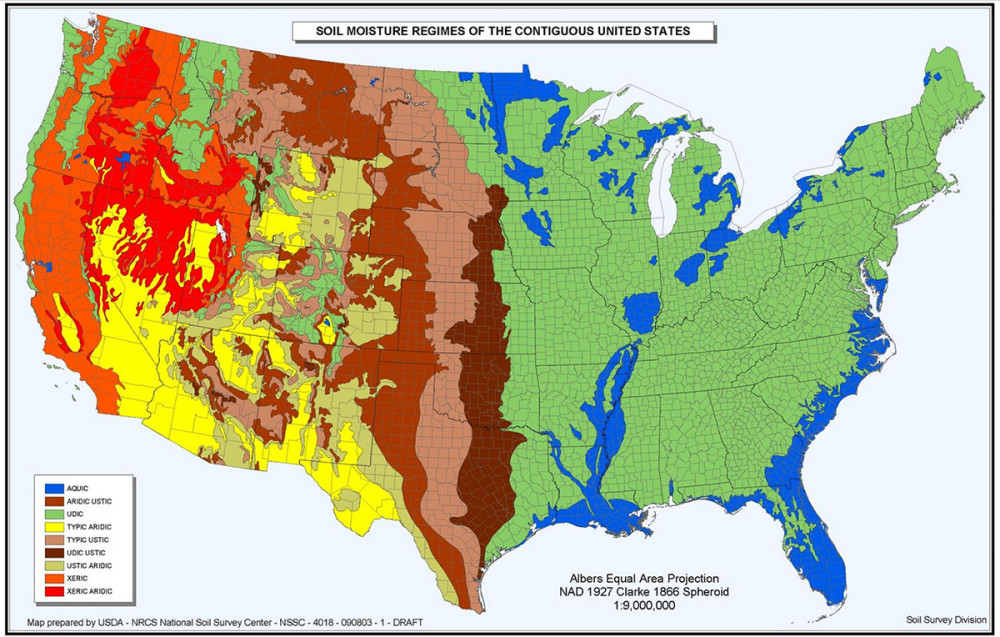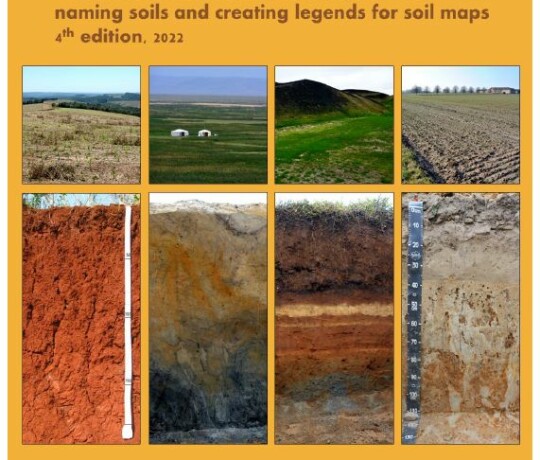US Soil Taxonomy (ST)
Developed by United States Department of Agriculture and the National Cooperative Soil Survey
An elaborate classification of soil types according to several parameters and in several levels

Soil taxonomy: A basic system of soil classification for making and interpreting soil surveys (United States Department of Agriculture/Natural Resources Conservation Centre) provides an elaborate classification of soil types according to several parameters and in several levels: Order, Suborder, Great Group, Subgroup, Family, and Series. The latest version is the 2nd edition published in 1999.
There also is a Keys to Soil Taxonomy document providing the taxonomic keys necessary for the classification of soils in a form that can be used easily in the field. It also acquaints users of soil taxonomy with recent changes in the classification system, incorporating all changes approved since 1999.
Horizon Definitions are provided in Chapter 3, and the Identification Key starts in Chapter 4 and then branches to the appropriate chapter for further distinction within each soil order.
The US Soil Taxonomy has an Hierarchical Structure with Four primary levels:
Orders
US Taxonomic Orders distinguish eleven fundamental types of mineral soils and one organic soil. Each Order has a distinct horizon configuration.
Suborders
The Orders are divided into soil 64 Suborders (with over 30 in NZ) primarily on the basis of properties that influence soil formation and/or are important to plant growth.
Great groups
The soil Suborders are divided into Great groups on the basis of similarities in horizons present, soil moisture or temperature regimes, or other significant soil properties. Great groups provide more detail about the range of soils included in each soil Suborder. There are over 500 Great groups.
Subgroup
The soil Great groups are divided into Subgroups, which provide more detail about the range of soils included in each soil Great group. There are over 2500 Subgroups.
Family
Families are established within a subgroup on the basis of physical and chemical properties along with other characteristics that affect management.
Series
The series consists of soils within a family that have horizons similar in color, texture, structure, reaction, consistence, mineral and chemical composition, and arrangement in the profile.
An example of US Soil Taxonomy:

On the fun side of things, Pete Bier has written an 'Ode to Soil Orders':
In 1978 and 1979, Dr Guy Smith, the principal author of Soil Taxonomy, resided at the NZ Soil Bureau, in Wellington, working mainly with Mike Leamy and Roger Parfitt. A commitment was made to test Soil Taxonomy for a period of 5 years.

G.D. Smith, major author of U.S.D.A. Soil Taxonomy, who was stationed at Soil Bureau in 1978 and 1979.
This decision stimulated forceful debate from those who appreciated the holistic nature of the New Zealand Genetic Soil Classification and objected to the regimentation of precisely defined classes. The testing proceeded with great energy. New soil surveys began with legends based on Soil Taxonomy. A substantial number of pedons were comprehensively analysed and added to the National Soils Database (NSD).
New Zealand soil scientists became heavily committed to the international development of Soil Taxonomy, and had a significant role in the establishment of the Andisols order of Soil Taxonomy in particular.
When Guy departed for Belgium, Mike Leamy took the role of chairman of the international Andisol committee ICOMAND, and visited most of the worlds Andisol locations, working with numerous associates, strung out across the earth’s tectonically active regions and volcanic hotspots. This work culminated in the addition of the Andisols order chapter to Soil Taxonomy, and ultimately to Allophanic and Pumice Soils orders of the NZSC.
Sadly Mike Leamy died during the later stages of the Andisols work and the completion of the final proposal and paper was published by Roger Parfitt and Ben Clayden in 1991.
However, for those working in the New Zealand soil survey program, difficulties were becoming apparent:
Fragipans, common in New Zealand loess soils, occurred predominantly in soils with ustic moisture regimes, whereas in Soil Taxonomy they were associated with soils having udic moisture regimes.
The use of carbonates as a surrogate for soil moisture regimes in Soil Taxonomy failed as a criterion in New Zealand soils which are generally carbonate-free.
The carbon limits for fluventic subgroups were too low for New Zealand soils, forcing the assignment of many mature soils to fluventic subgroups.
While Guy Smith was resident in New Zealand, he made many recommendations for amendments to Soil Taxonomy to meet New Zealand conditions.
It was becoming clear, however, that we could not expect major changes to accommodate the temperate soils of New Zealand. The parts of Soil Taxonomy under revision were largely concerned with tropical soils. Apart from the Andisols, the small New Zealand tail could not wag such a large dog.
At the end of the testing period, it was decided that the New Zealand Soil Bureau would not adopt Soil Taxonomy as its prime soil classification and that a revised New Zealand Soil Classification would be developed (see also Leamy et al. 1983).
The principal reason given was that Soil Taxonomy made inadequate provision for important classes of New Zealand soils. The Inceptisols, Andepts apart, are the most widespread soils in New Zealand, and presented the most difficulties. While the custodians of Soil Taxonomy were making commendable efforts to introduce amendments, there was little prospect of changes being introduced with the speed necessary to meet the operational needs of the soil survey.
The time spent applying Soil Taxonomy in New Zealand was by no means wasted:
- New Zealand soil scientists became familiar with the principles and classes of what has become an important international soil classification. DSIR has used it as its prime system in all the Pacific Islands work, and it helped place New Zealand soils in a clearer international context.
- Application in New Zealand stimulated much research. Of particular value to later work was the growth of the National Soils Database, which includes a large number of fully characterized pedons.
- Third, the experience with all its soul-searching and controversy drew the venom of change and paved the way for development of the New Zealand Soil Classification.
Allan Hewitt generously granted permission to use some of his 1992 publication on 'Soil Classification in New Zealand - Legacy and lessons' to compile the above text.


